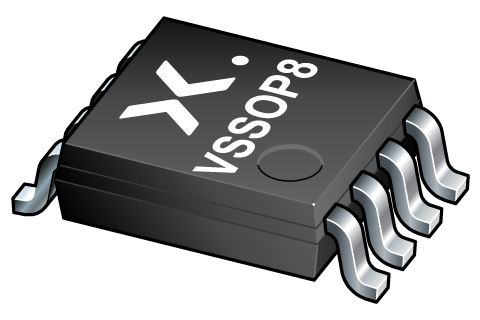Orderable parts
| Type number | Orderable part number | Ordering code (12NC) | Package | Buy from distributors |
|---|---|---|---|---|
| 74AVC9112DC | 74AVC9112DCH | 935690124125 | SOT765-1 | Order product |

Register once, drag and drop ECAD models into your CAD tool and speed up your design.
Click here for more information1-to-4 fan-out buffer
The 74AVC9112 is a 1-to-4 fan-out buffer suitable for use in clock distribution. It has a data input (A), four data outputs (Yn) and an output enable input (OE). VCC can be supplied at any voltage between 0.8 V and 3.6 V. A HIGH on OE causes all outputs to be pulled LOW via pull-down resistors, a LOW on OE disconnects the pull-down resistors and enables all outputs.
Schmitt trigger action at all inputs makes the circuit tolerant for slower input rise and fall time.
The IOFF circuitry disables the output, preventing any damaging backflow current through the device when it is powered down.
Wide supply voltage range:
VCC: 0.8 V to 3.6 V
Inputs accept voltages up to 3.6 V
Maximum data rates:
380 Mbit/s (3.3 V)
200 Mbit/s (2.5 V)
200 Mbit/s (1.8 V)
150 Mbit/s (1.5 V)
100 Mbit/s (1.2 V)
Latch-up performance exceeds 100 mA per JESD 78 Class II
Complies with JEDEC standards:
JESD8-12 (0.8 V to 1.3 V)
JESD8-11 (0.9 V to 1.65 V)
JESD8-7 (1.2 V to 1.95 V)
JESD8-5 (1.8 V to 2.7 V)
JESD8-B (2.7 V to 3.6 V)
ESD protection:
HBM: ANSI/ESDA/JEDEC JS-001 class 3B exceeds 8000 V
CDM: ANSI/ESDA/JEDEC JS-002 class C3 exceeds 1000 V
Specified from -40 °C to +85 °C and -40 °C to +125 °C
| Type number | VCC (V) | Logic switching levels | Output drive capability (mA) | fmax (MHz) | Nr of bits | Power dissipation considerations | Tamb (°C) | Rth(j-a) (K/W) | Rth(j-c) (K/W) | Package name |
|---|---|---|---|---|---|---|---|---|---|---|
| 74AVC9112DC | 0.8 - 3.6 | CMOS/LVTTL | ± 12 | 190 | 1 | very low | -40~125 | 194 | 104 | VSSOP8 |
| Model Name | Description |
|---|---|
|
|
| Type number | Orderable part number, (Ordering code (12NC)) | Status | Marking | Package | Package information | Reflow-/Wave soldering | Packing |
|---|---|---|---|---|---|---|---|
| 74AVC9112DC | 74AVC9112DCH (935690124125) |
Active | Bb |

VSSOP8 (SOT765-1) |
SOT765-1 | SOT765-1_125 |
| Type number | Orderable part number | Chemical content | RoHS | RHF-indicator |
|---|---|---|---|---|
| 74AVC9112DC | 74AVC9112DCH | 74AVC9112DC |
|
|
| File name | Title | Type | Date |
|---|---|---|---|
| 74AVC9112 | 1-to-4 fan-out buffer | Data sheet | 2024-07-08 |
| AN90007 | Pin FMEA for AVC family | Application note | 2018-11-30 |
| Nexperia_document_guide_MiniLogic_PicoGate_201901 | PicoGate leaded logic portfolio guide | Brochure | 2019-01-07 |
| SOT765-1 | 3D model for products with SOT765-1 package | Design support | 2020-01-22 |
| avc9112 | 74AVC9112 IBIS model | IBIS model | 2018-06-18 |
| Nexperia_package_poster | Nexperia package poster | Leaflet | 2020-05-15 |
| VSSOP8_SOT765-1_mk | plastic, very thin shrink small outline package; 8 leads; 0.5 mm pitch; 2 mm x 2.3 mm x 1 mm body | Marcom graphics | 2017-01-28 |
| SOT765-1 | plastic, very thin shrink small outline package; 8 leads; 0.5 mm pitch; 2 mm x 2.3 mm x 1 mm body | Package information | 2022-06-03 |
| SOT765-1_125 | VSSOP8; Reel pack for SMD, 7''; Q3/T4 product orientation | Packing information | 2020-04-21 |
| 74AVC9112DC_Nexperia_Product_Reliability | 74AVC9112DC Nexperia Product Reliability | Quality document | 2025-03-20 |
If you are in need of design/technical support, let us know and fill in the answer form we'll get back to you shortly.
The Nexperia Longevity Program is aimed to provide our customers information from time to time about the expected time that our products can be ordered. The NLP is reviewed and updated regularly by our Executive Management Team. View our longevity program here.
| Model Name | Description |
|---|---|
|
|
| Type number | Orderable part number | Ordering code (12NC) | Status | Packing | Packing Quantity | Buy online |
|---|---|---|---|---|---|---|
| 74AVC9112DC | 74AVC9112DCH | 935690124125 | Active | SOT765-1_125 | 3,000 |
|
As a Nexperia customer you can order samples via our sales organization.
If you do not have a direct account with Nexperia our network of global and regional distributors is available and equipped to support you with Nexperia samples. Check out the list of official distributors.
The interactive datasheets are based on the Nexperia MOSFET precision electrothermal models. With our interactive datasheets you can simply specify your own conditions interactively. Start by changing the values of the conditions. You can do this by using the sliders in the condition fields. By dragging the sliders you will see how the MOSFET will perform at the new conditions set.